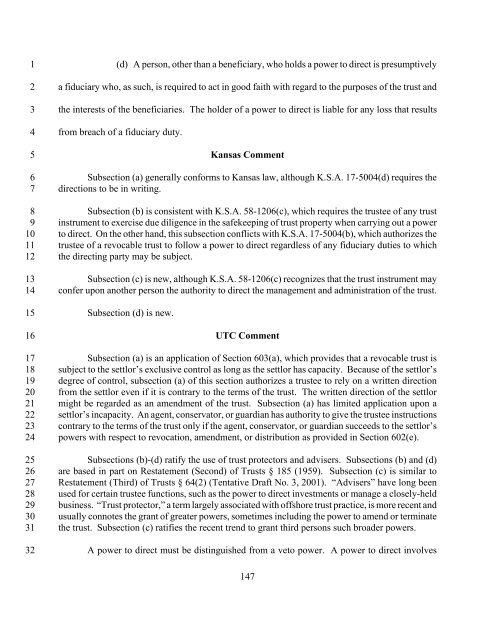uniform trust code - Kansas Judicial Branch
uniform trust code - Kansas Judicial Branch
uniform trust code - Kansas Judicial Branch
Create successful ePaper yourself
Turn your PDF publications into a flip-book with our unique Google optimized e-Paper software.
1<br />
2<br />
3<br />
4<br />
5<br />
6<br />
7<br />
8<br />
9<br />
10<br />
11<br />
12<br />
13<br />
14<br />
15<br />
16<br />
17<br />
18<br />
19<br />
20<br />
21<br />
22<br />
23<br />
24<br />
25<br />
26<br />
27<br />
28<br />
29<br />
30<br />
31<br />
32<br />
(d) A person, other than a beneficiary, who holds a power to direct is presumptively<br />
a fiduciary who, as such, is required to act in good faith with regard to the purposes of the <strong>trust</strong> and<br />
the interests of the beneficiaries. The holder of a power to direct is liable for any loss that results<br />
from breach of a fiduciary duty.<br />
<strong>Kansas</strong> Comment<br />
Subsection (a) generally conforms to <strong>Kansas</strong> law, although K.S.A. 17-5004(d) requires the<br />
directions to be in writing.<br />
Subsection (b) is consistent with K.S.A. 58-1206(c), which requires the <strong>trust</strong>ee of any <strong>trust</strong><br />
instrument to exercise due diligence in the safekeeping of <strong>trust</strong> property when carrying out a power<br />
to direct. On the other hand, this subsection conflicts with K.S.A. 17-5004(b), which authorizes the<br />
<strong>trust</strong>ee of a revocable <strong>trust</strong> to follow a power to direct regardless of any fiduciary duties to which<br />
the directing party may be subject.<br />
Subsection (c) is new, although K.S.A. 58-1206(c) recognizes that the <strong>trust</strong> instrument may<br />
confer upon another person the authority to direct the management and administration of the <strong>trust</strong>.<br />
Subsection (d) is new.<br />
UTC Comment<br />
Subsection (a) is an application of Section 603(a), which provides that a revocable <strong>trust</strong> is<br />
subject to the settlor’s exclusive control as long as the settlor has capacity. Because of the settlor’s<br />
degree of control, subsection (a) of this section authorizes a <strong>trust</strong>ee to rely on a written direction<br />
from the settlor even if it is contrary to the terms of the <strong>trust</strong>. The written direction of the settlor<br />
might be regarded as an amendment of the <strong>trust</strong>. Subsection (a) has limited application upon a<br />
settlor’s incapacity. An agent, conservator, or guardian has authority to give the <strong>trust</strong>ee instructions<br />
contrary to the terms of the <strong>trust</strong> only if the agent, conservator, or guardian succeeds to the settlor’s<br />
powers with respect to revocation, amendment, or distribution as provided in Section 602(e).<br />
Subsections (b)-(d) ratify the use of <strong>trust</strong> protectors and advisers. Subsections (b) and (d)<br />
are based in part on Restatement (Second) of Trusts § 185 (1959). Subsection (c) is similar to<br />
Restatement (Third) of Trusts § 64(2) (Tentative Draft No. 3, 2001). “Advisers” have long been<br />
used for certain <strong>trust</strong>ee functions, such as the power to direct investments or manage a closely-held<br />
business. “Trust protector,” a term largely associated with offshore <strong>trust</strong> practice, is more recent and<br />
usually connotes the grant of greater powers, sometimes including the power to amend or terminate<br />
the <strong>trust</strong>. Subsection (c) ratifies the recent trend to grant third persons such broader powers.<br />
A power to direct must be distinguished from a veto power. A power to direct involves<br />
147

















